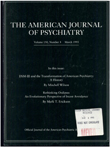Quantitative electroencephalography: a report on the present state of computerized EEG techniques. American Psychiatric Association Task Force on Quantitative Electrophysiological Assessment
Abstract
The American Psychiatric Association established the Task Force on Quantitative Electrophysiological Assessment in May 1989 to consider several questions of interest to psychiatrists. From the inception of techniques for quantitative electroencephalography (qEEG), the possibility was raised that it would substantially assist in the diagnosis of brain disorders. However, controversy exists over the scientific basis for such approaches and the training necessary for interpretation of computerized records. The task force's charge was to report 1) the present state of scientific knowledge about qEEG, 2) the role of qEEG in clinical psychiatric practice at the present time, 3) the training necessary for the use of qEEG techniques, and 4) the possible future of the technique in the study of mental disorders. The task force concluded that qEEG is particularly useful for the detection of abnormalities in slow waves, which are a feature of delirium, dementia, intoxication, and other syndromes involving gross CNS dysfunction. The ability of qEEG to help in the diagnosis of other disorders, such as schizophrenia or depression, is not yet established. Clinical replications and sharing of normative and patient data bases are necessary for the advancement of this field. Proper use of this technique requires extensive training in a center experienced in its use. Standards for training and for using the technology in psychiatry are urgently needed. This report was approved by the Board of Trustees in December 1990.
Access content
To read the fulltext, please use one of the options below to sign in or purchase access.- Personal login
- Institutional Login
- Sign in via OpenAthens
- Register for access
-
Please login/register if you wish to pair your device and check access availability.
Not a subscriber?
PsychiatryOnline subscription options offer access to the DSM-5 library, books, journals, CME, and patient resources. This all-in-one virtual library provides psychiatrists and mental health professionals with key resources for diagnosis, treatment, research, and professional development.
Need more help? PsychiatryOnline Customer Service may be reached by emailing [email protected] or by calling 800-368-5777 (in the U.S.) or 703-907-7322 (outside the U.S.).



